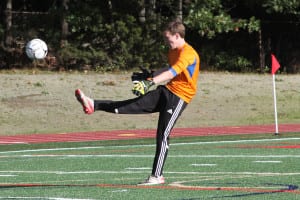By Matthew Kearns, DVM
Whew!! Hurricane Joaquin has drifted out to sea! Unfortunately, we have become all too familiar with natural disasters — think Superstorm Sandy. If another disaster were to occur, would I be prepared not only for myself, but also for my pet? What about for everyday emergencies?
Believe it or not, many of the same precautions and treatments we would use on ourselves we can also extend to our more “furry” family members: a basic first aid kit specifically for our pets, an emergency plan available in advance, etc. A basic first aid kit for your pet should include a blanket, thermometer, pen light, sterile 4×4 gauze pads, sterile dressing (small, medium, large), roll gauze, 1 and 2 inch white tape, Telfa non stick bandages, triangular bandages and safety pins, cloth strips, betadine or triple antibiotics, scissors, tweezers, instant cold pack, hydrogen peroxide, splint, veterinarian’s phone number, local animal emergency clinic’s phone number, Poison Control’s phone number, Glucose concentrate (e.g., Karo Syrup or other syrup), canned dog or cat food and bottled water.
Once you have your first aid kit prepared, you will be ready for most emergencies at home. Here are some tips on handling most general emergencies:
*If an animal is frightened or in pain, it may bite, even friendly dogs or cats. Consider using something like a small piece of rope or a tie to muzzle your pet, or throw a large thick blanket over the pet to pick it up. Please do not get yourself hurt trying to help a scared, injured, potentially dangerous animal.
*Anything makes a good stretcher — a flat board, an old door, etc.
*If an animal is vomiting for whatever reason, do not offer any food or water for at least three hours. We know there is a concern of dehydration, but many times that is the time an animal needs to rest the stomach, if it is a less serious cause of vomiting, and giving any food or water too quickly may make things worse. If you are very concerned, it is better to check with or visit your regular veterinarian or an emergency veterinary hospital before considering food or water.
*For bite wounds or penetrating wounds, try to keep the wound clean and moist until the animal can be transported to your regular veterinarian or an emergency veterinary hospital. Moistened clean cloths, gauze, etc can be used. If there is excessive bleeding, direct pressure should be applied; consider an ACE bandage. Do not try to remove anything that is impaled into the pet.
*Bone fractures can be immobilized with a splint. A splint can be made of rolled up magazines or newspapers, cardboard, a metal hanger, or wood. If it is an open compound fracture, cover it with a clean moistened dressing. If the animal cannot or will not allow a splint, just try to keep them confined until you can transport them to either your regular veterinarian’s office or an emergency veterinary hospital.
*If you suspect your dog has ingested poison, call a veterinary emergency poison hotline. If possible, have both the trade name and the generic name of the poison. Do not try to get the animal to vomit before speaking to a veterinary emergency poison control representative or licensed veterinarian. Certain poisons, particularly those that are caustic, may cause more damage on the way back up, and if your pet is disoriented from the poison, you risk aspiration and aspiration pneumonia.
The emergency clinic I work for recommends the National Animal Poison Control Center: (888) 299-2973. They are staffed 24 hours a day, 365 days a year with veterinary toxicologists. There is a $45 consult fee, but it is well worth it. I hope this information helps to make us all better prepared for emergencies.
Dr. Kearns has been in practice for 16 years and is pictured with his son, Matthew, and his dog, Jasmine.






























